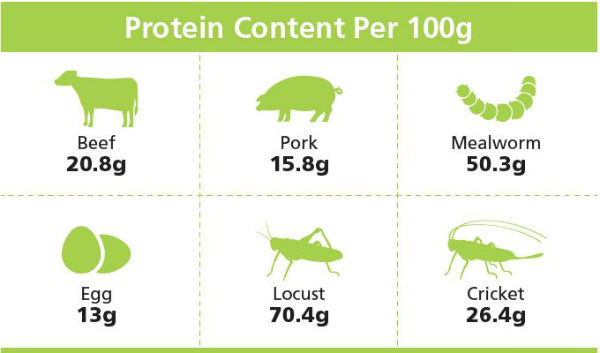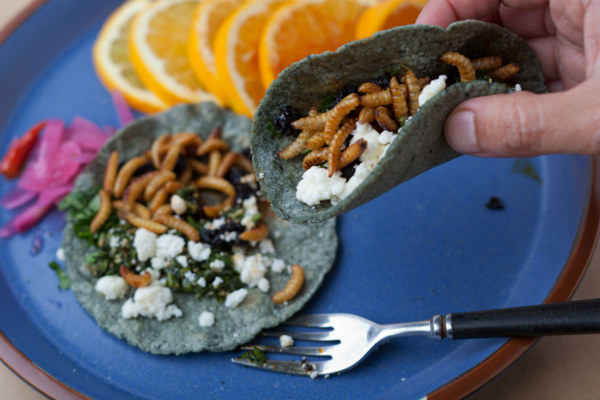Last month, there was a unique food contest which caught the public eye. It was the “Insect Food Contest” held at the World Insect Expo in Yecheon. It may sound strange and unfamiliar to some readers, but insects are already considered a super food for the future, perfect in every aspect. The Sungkyun Times (SKT) explores the world of edible insects, suggests their merits, and introduces the current state of the edible insect industry.
Concept of Edible Insects and Its Necessity
• What Are Edible Insects?
Edible insects literally indicate any insects suitable for consumption, including those used for medicines and feed for cattle. Human consumption of insects has a long history. It is known that the Chinese royal family ate insects 3,000 years ago, and the Bible also recorded of people consuming insects. The number of insect species appropriate for eating consists of more than 1,900 species. Contrary to general beliefs, insects are not just an emergency food that substitute “normal food.” Rather, they are also parts of everyday diets or local delicacies in many countries.
• Why Is It Needed?
At present, one ninth of the entire world population is suffering from hunger. Supplying enough food, however, is becoming more difficult because of the rapid population growth. According to the Food and Agricultural Organization (FAO), if this growth trend continues, the amount of food needed worldwide will double by 2050. Global warming and desertification are other important factors that threaten food security. The World Bank has warned that the crop yields will decline by 30% due to severe climate change by the end of this century. The problem of traditional meat consumption is that it worsens the worldwide famine even more. One third of all farmed crops are used to feed cattle globally. For instance, about eight kilograms of grains are put into producing just 100g of beef. If such crops were well redistributed, it would be sufficient to feed all starving people. Therefore, it is crucial to gradually reduce global meat consumption and develop a brand-new source of protein. In 2013, the FAO officially proposed edible insects as the most promising future food resources, naming them “little cattle.”
Korea is also no longer safe from the threat of food security. In Korea, almost all crops used to feed cattle are imported. This means that the price of meat can fluctuate according to the change in the world crop price. Therefore, in the long run, Koreans might consider edible insects as a way to enhance food self-sufficiency.
For these reasons, the edible insect industry is gaining much attention nowadays. The global market size of edible insects in 2015 was $11 trillion and is expected to reach $38 trillion in 2020. In addition, the European Union (EU) is investing four million dollars annually to develop edible insect products too. Popular Science, a well-known American science magazine, also chose edible insect drinks as a food of 2015.
Benefits of Edible Insects
• Superiority in Nutrition and Excellent Taste
First of all, insects have more protein than any other traditional meats, as well as a balance between three major nutrients, carbohydrates, proteins, and fats. Moreover, edible insects are rich in unsaturated fatty acids and essential fatty acids which are better for our health than saturated fatty acids. The nutrition components of insects are known to be similar to those of eggs, which are often called “complete foods.” Therefore, bugs can work as a good alternative source of nutrients for vegetarians and religious people who cannot or do not consume traditional meats. The abundant nutrition in insects means that they can be used as food aids for those who are suffering from chronic hunger. Currently, FBF (Fortified Blended Food) products, the most common food aid provided by the United Nations, has soybean as a main ingredient. Using soybean, however, is undesirable due to high import costs, whereas edible insects are economical because they can be collected by local residents.

Nonetheless, no matter how nutritious food is, it would be meaningless if it does not taste nice. Edible insects are also well known for their rich tastes. Since there are so many species, it is hard to generalize their taste, although they mostly have nutty flavors. They have very mild tastes so they blend and go well with various dishes.
• Environment-Friendliness
Another factor which makes insects a desirable food alternative is that they cause much less harm to the environment. In fact, insects are expected to be the most sustainable diet. The FAO defines sustainable diets as “diets with low environmental impacts which contribute to food and nutrition security and to healthy life for present and future generations.” Compared to cattle, raising insects has much less requirements. For instance, it only requires one third of the water, one fourth of the feed, and one tenth of the land compared with raising cows. Furthermore, farming insects is almost carbon dioxide free, which indicates it does not induce global warming. Not only that, insects can be raised using composts or excreta of cattle. About 1.3 billion tons of agricultural waste are recycled by farming insects annually.


• Contributions to Preserve Local Diets
Even now, at least two billion people in 113 countries are consuming insects as their traditional diets. Although insect dishes are completely normal practice in some regions, they have been a strongly avoided in western societies. This bias reflects the feelings of aversion and superiority to other cultures which consume insects. Through westernization, numerous traditional cuisines using insects are disappearing one by one. In Mali, locusts were severely contaminated because of pesticides introduced in plantations. Consequently, after large cotton plantations were built by France, local residents became unable to use insects as a food source.

Positive attitudes about edible insects can help conserve diverse food cultures which are being forgotten. It can also instill pride to local residents about their own culture. There are some movements restoring traditional local cuisines. For example, Don Bugito, a project which sells street food made of insects, is inspired by the fact that the indigenous people of Mexico have enjoyed insect foods before the Spanish conquest.
Edible Insects Industry in Korea
In Korea, currently seven species are formally approved for consumption by the Korea Food and Drugs Administration. Even though the edible insect industry in Korea is in its beginning, it is growing at a fast rate. The number of edible insect farms in Korea has tripled during the last five years (2011-2015), from 265 to 724. Moreover, CJ CheilJedang, one of the major Korean food companies, has started working on the development of insect food products beginning this March, aiming to launch them by the end of this year. Considering that locusts and silkworm pupas are still eaten as snacks, experts are anticipating that popularizing insect food products will be much easier than in Western society. To make the edible insect industry successful, the first task to overcome is people’s repulsion and disgust. “Papillon’s Kitchen,” the first insect restaurant in Korea, is employing various methods to change the public perception of edible insects. In this restaurant, it is hard to associate the food to insects, since every ingredient (insects) is processed into a completely different form. The oil extracted from mealworms and rice infused with locust proteins do not show any outward difference from ordinary ingredients. In addition, the restaurant provides unbiased information and detailed explanations about edible insects to customers while serving the meal. Likewise, there are many attempts to improve public awareness and to successfully introduce edible insects in Korea.
When potatoes were first introduced to Western countries, they were called “the Devil’s Apple.” They were shunned and treated as just feed for cattle because of their distinctive looks. Perhaps, it is only peoples’ prejudice that prevents them from experiencing a new world of taste. In the not-so-distant future, it might be possible to find “cricket energy bars” or “mealworm cookies” in a nearby supermarket.
